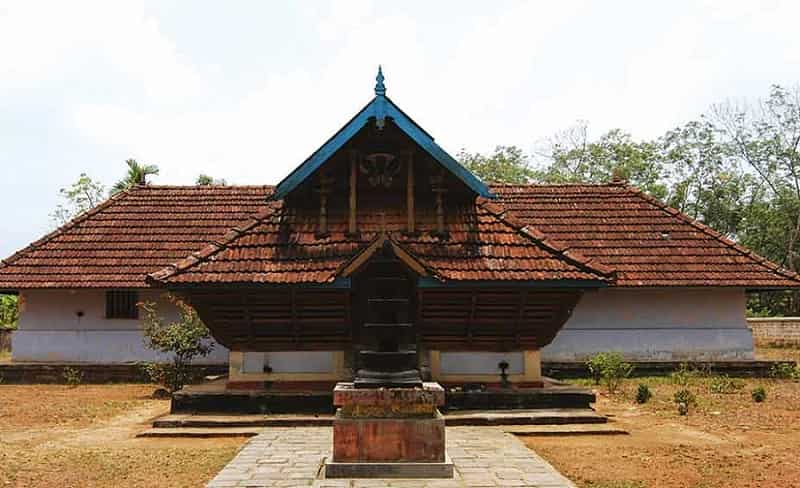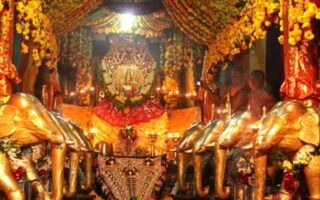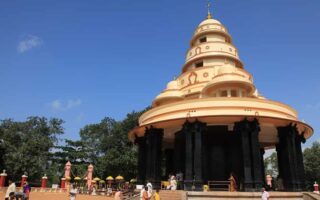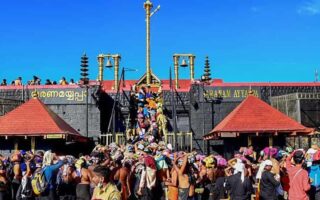- Location: Near Thalayolaparambu, Kottayam, Kerala.
- Main Deity/Deities: Lord Vishnu
- Major Attraction: Mural Paintings
- Timings: 7:30 AM and 9:30 AM
- Entry Fee: No entry fee
- Time Required: 30 minutes to 1 hour
Pundareekapuram Temple is situated on a raised portion called Midayikunnam. An important temple of Kottayam, this temple is built in the basic architectural form which is typical to the temples of Kerala. Devoted to Lord Vishnu whose image is shown to be relaxing on his famous vehicle Garuda, the temple looks quite simple from its appearance.
- Also Read: Most Famous Lord Vishnu Temples in India

Description of the temple: The temple is built with a saddle-shaped roof which is commonly called “Chuttambalam”. A square shaped sanctum forms the part of the interior. The image of the deity is worshipped at a place called “Balikkalpura”. Here the sacred idol of Vishnu is shown to sitting with Garuda, his vehicle that takes him from one place to the other. Another deity that is worshipped here is Bhoodevi. The total area covered by the temple is about one acre.
Murals: The most important thing that will strike you as you visit Pundareekapuram Temple is the presence of exclusive art that is manifested in the form of mural paintings on the walls of the temple. The themes of these epics have been drawn from Hindu mythology, its epics as well as puranas. These exclusive paintings are considered best among all the paintings of Kerala.
There are a number of panels that depict various stories and incidents. Some of these panels are quite large in size while a majority of them are small. Among the most prominent mural that form part of this temple is that of Shiva and his consort Parvati; they are shown to sitting under a Kalpvriksha tree. Among the other illustrations that will appeal your eyes include Krishna playing pranks, goddess Durga killing the ferocious demon Mahishasur, Lord Rama’s coronation ceremony, and the famous dance of Shiva in angry mood.
Most of these paintings have been preserved in their original form and remained untouched from human interference for a very long time. It is because Pundareekapuram Temple is located in an obscure area that lies away from the main city. You will notice the striking beauty of these murals which is comparable to the paintings of Padmanabhapuram palace.
As you will look at them, you will also notice that most of the mural painted on the east and north walls look amazingly fresh. Though a whole lot of them are works of 18th century, they look very fresh. A number of other paintings that have been depicted on the other two set of walls look somewhat faded. It is because of the fact that they bear monsoonal torrents every year.
The impressive image of goddess Durga beheading Mahishasura is worth-watching. It is quite a big painting with dimensions 1.45 m by 1.65 m. The fury of the deity will strike your mind and soul. This particular mural depicts battle scenes between the two characters, an unlikely happening in the paintings of other temples where only the victory of Durga is emphasized.
Another mural that is present nearby is that of Yakshini looking into a mirror. Beautiful palm tree forms the picturesque background. Each leave of the tree is painted with dexterity. Yakshini is depicted as a woman of exquisite beauty which is enhanced by her full bosom and lovely hair.
If you are looking for more thrill, just have a look at the murals of Krishna that focus on this childhood pranks and miracles. At some places, he is depicted in his usual form where he steals butter; at other places, incidents drawn form his life are illustrated. A mural show him killing Putana while another depicts him dancing over serpent hood.
Yet another panel of Pundareekapuram Temple is devoted to the pastoral life of Vrindavan, where Krishna is playing charming tune on a flute and the villagers getting lost in the melody. As an onlooker, you are going to get enthralled at the pictorial representation of the rural life. Vivid colors are chosen to depict several characters. Lord is painted in green while his female companions are painted in lighter shades.
Pattabhishekam or the coronation ceremony of Rama is another charming mural that will looks quiet graceful and elegant. A number of sages that are shown to be sitting in the court include Kashyap, Vamadeva, Suka and Vashishta. Father and brothers of lord Rama can also be seen in this mural painting.
The painting that is considered a masterpiece of Pundareekapuram Temple is that of hunting god, Sastha. He is shown to be chasing some animals. His entire crew is present on the spot. Several animals like pigs and leopards are seen making noises of different kind. You will see that attitude that the hunter wares in the picture symbolizes his hunting purpose. The painting looks quiet real and the awesome depiction of the horse will charm your senses.
The characteristic features that are unique to these illustrations are line-accuracy and organic unity, and use of colors to show symbolism.
It is the mural paintings that are the center of attraction of this otherwise simple temple.
Weather
- Summer (March to June): During the summer months, the weather in Thalayolaparambu can be warm and humid, with temperatures ranging from 30°C to 35°C (86°F to 95°F).
- Monsoon (June to September): The monsoon season brings heavy rainfall to the region, with lush greenery all around. Rainfall can be intense during this period.
- Post-Monsoon (October to November): After the monsoon, the weather becomes more pleasant, with temperatures ranging from 25°C to 30°C (77°F to 86°F).
- Winter (December to February): The winter season is relatively mild and comfortable, with daytime temperatures ranging from 20°C to 25°C (68°F to 77°F).
Best Time to Visit
The best time to visit Pundareekapuram Vishnu Temple is during the post-monsoon and winter months, from October to February when the weather is comfortable for temple visits and outdoor exploration. This period also coincides with many important festivals celebrated at the temple.
How to Reach
- By Air: The nearest airport is Cochin International Airport, which is approximately 60 kilometers (37 miles) away from Thalayolaparambu. From the airport, you can hire a taxi or take a bus to reach the temple.
- By Train: Kottayam Railway Station is the nearest major railway station, located about 22 kilometers (14 miles) from Thalayolaparambu. From there, you can hire a taxi or take a local bus to reach the temple.
- By Road: Thalayolaparambu is well-connected by road. You can reach it by bus or taxi from nearby cities like Kottayam.


